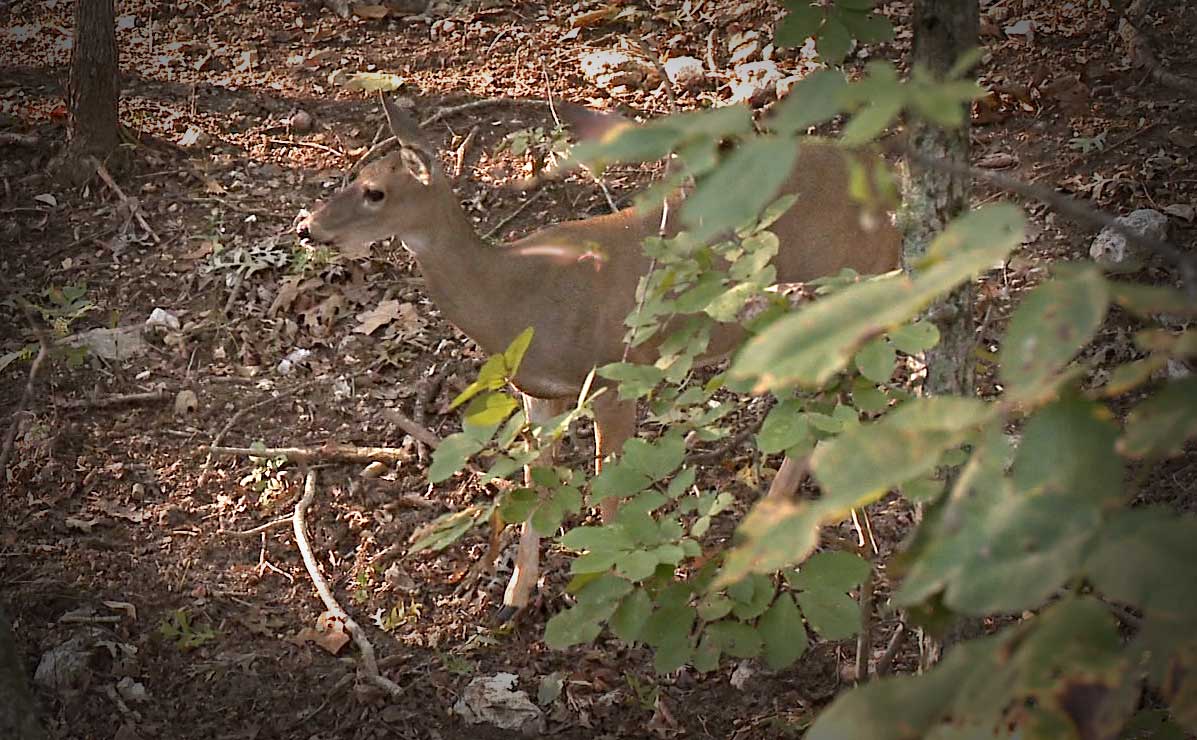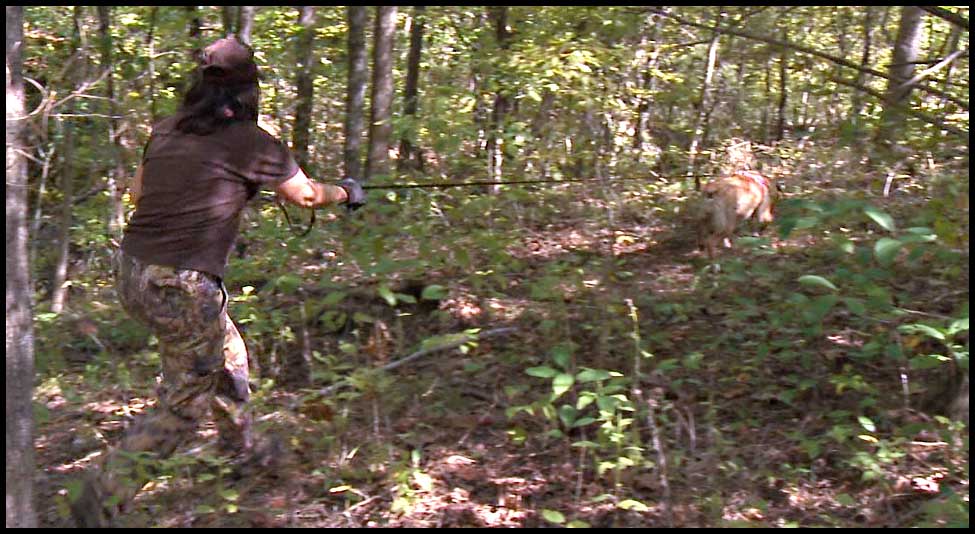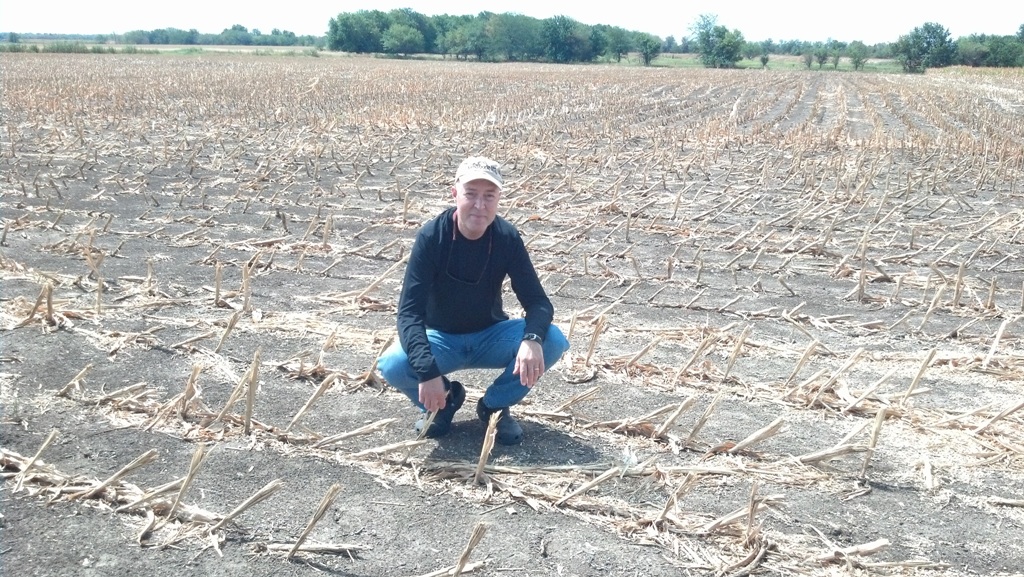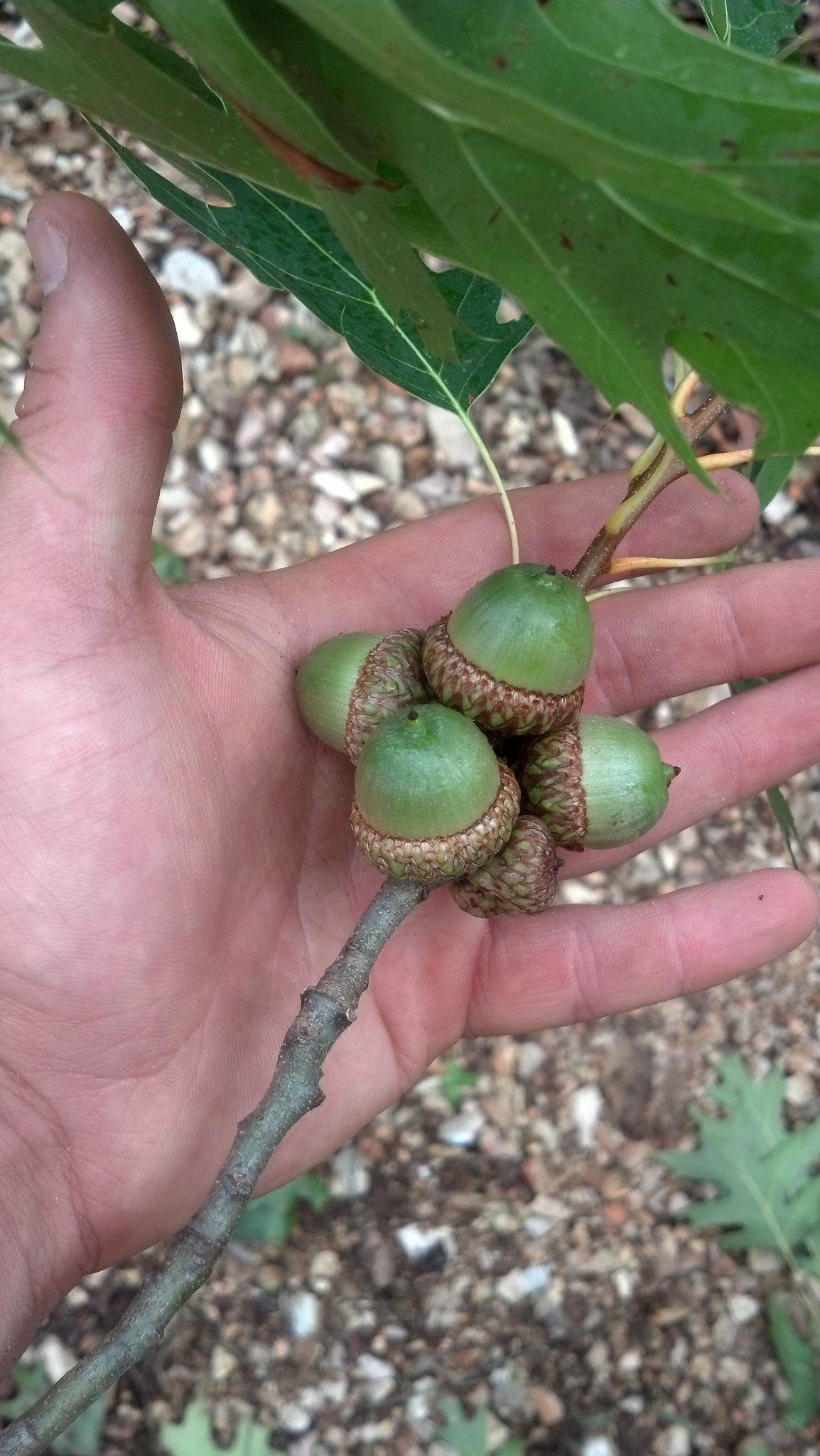Category: Hunting Tactics
Scent Control: An Essential for Consistently Harvesting Mature Bucks
Last week I explained the importance of hunters reducing scent on them and their gear so they don’t alert mature bucks. This week I wished to share the system I use to accomplish this goal.
A good scent control system should reduce enough of the scent of a hunter and his gear so that bucks will approach the hunter close enough to allow for an ethical shot. It’s not just mature bucks that we need to worry about alerting. Spooking a doe or immature buck can alarm a mature buck enough that they won’t approach the area.
Given the wariness of most mature bucks and knowing that strange scents, or scents they associate with danger can cause them to go on high alert or change their path of travel, it’s critical that the scent reduction program covers gear and hunter from the time they go to their stand until they kill or exit the hunting area.
To accomplish this, Adam and I use the Dead Down Wind system. We wash our clothes with their soap. I use Dead Down Wind because it is enzyme based – not a bactericide. Dead bacteria often put off strong odors (ever smell a swamp?). I wish to break existing bacteria down and limit certain types of bacteria from growing on me and my gear.
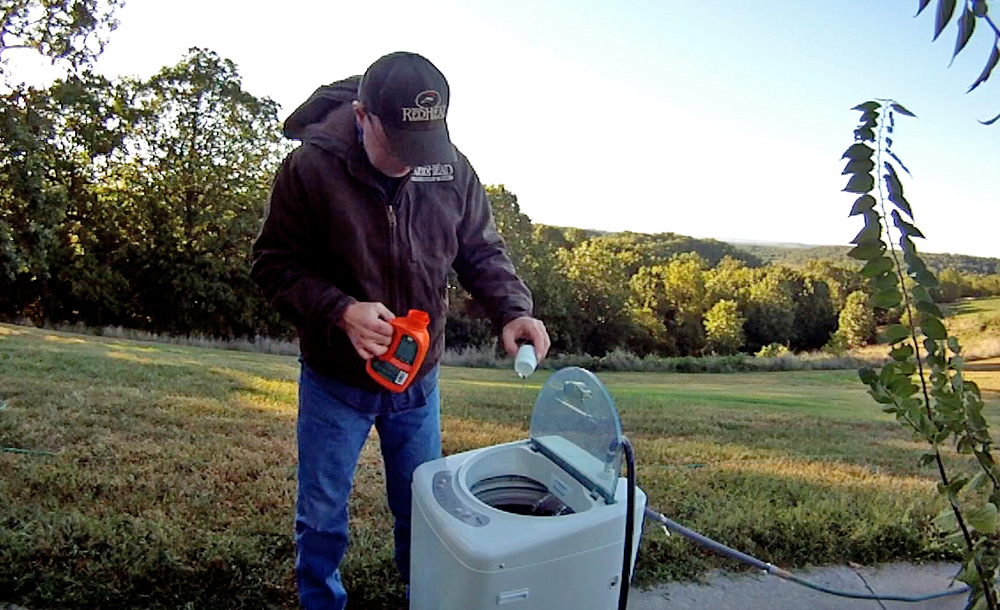
Doing laundry with Dead Down Wind ScentPrevent laundry detergent is an essential part of my scent reduction system
It doesn’t do much good to reduce the scent and odor causing agents on your body and then use a towel that is full of perfume, fabric softener, etc., which will simply apply a scent that is just as alarming to your body. Hence we buy some towels that are only used to dry ourselves when we are preparing to hunt. They are laundered, stored, etc. just like our hunting clothes.
Likewise, it does no good to remove odors from hunting clothes and then store them where they can absorb household and other smells that will alert deer. I prefer to air dry our clothes outside. If we are staying at a friend’s house we may use the dryer if there isn’t a place outside to air dry our clothes away from sources of odor (such as cars, lawn mowers, etc.).
Once our clothes are dry, we store them in a ScentMaster box. This clever device is a closed air system with a strong fan and air heater. It recirculates 130 degree air through the box and a large carbon filter. The warm air insures the clothes are totally dry and is not a friendly environment for smelly bacteria, mold, etc., to grow. This is a great method to store hunting clothes, and remove some odor that may have built up between hunts.
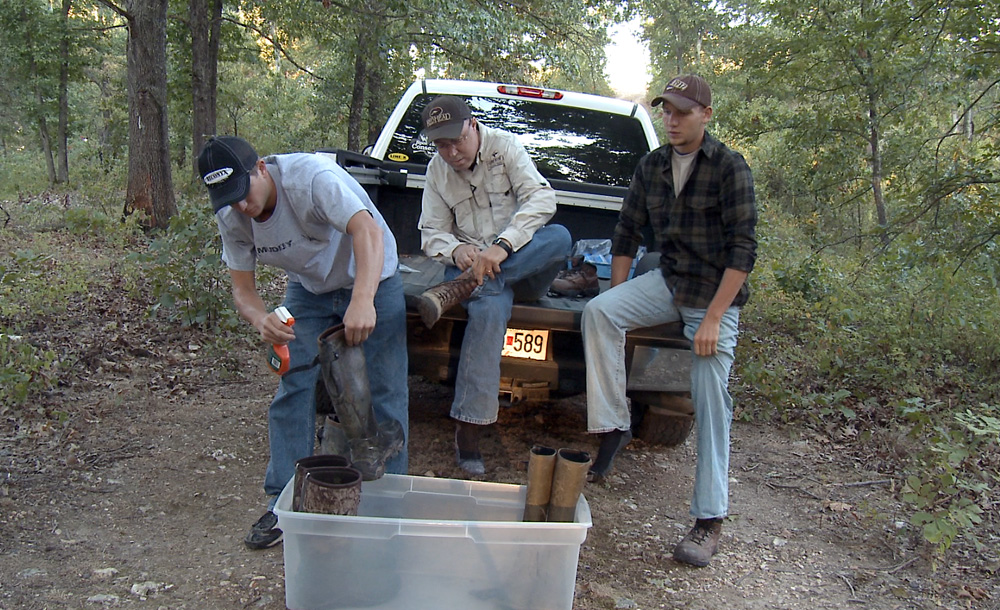
Applying Dead Down Wind ScentPrevent field spray before hunting leads to greater success at harvesting mature bucks
We’ll tote the ScentMaster box to our hunting location and change into our hunting clothes just before walking to our stand. Before we get dressed, we use the Dead Down Wind field spray to ensure our bodies, clothes, and gear are scent free as possible before heading to the stand. If we’ve been backpacking and/or camping we use the Dead Down Wind foam as an infield shower. The foam dries rapidly and is a great substitute for a shower.
Likewise we use the Field Spray to remove odors from our Nikon binos, range finders, etc.
Adam and I have filmed and killed several mature bucks while using our system of reducing scent. It’s certainly not fool proof. Such claims to the contrary are most likely false. But for most hunting situations, it’s proven to be very effective.
We produce a new episode each week – 52 weeks a year. We don’t have time to go on three hunts and only show the results of the best. You can see for yourself how well our scent reduction system works each week by simply watching GrowingDeer.tv.
Growing (and hunting) Deer together,
Grant
Why Scent Control Is Essential for Hunting Success
Unless you hunt in the desert, limiting the odor from you and your gear is one of the most important aspects of repeated success to harvesting mature bucks. Odor molecules travel better in moist air. Our dog, Crystal, can find sheds and follow blood trails much better when the humidity is higher. One time during a morning hunt I shot a doe high (GDTV 98). I tried to find the doe and lost the trail about noon. As the heat of the day increased the humidity dropped. Tracy, my wife, started Crystal on the trail from where I shot the deer. Crystal followed the trail as far as the blood was visible. Then she lost the trail.
We continued searching until late afternoon. Crystal wasn’t making any progress. All at once Crystal picked up the trail and I had my hands on the doe within minutes. What changed? The humidity increased as the air temperature dropped.
Ever wonder why bucks primarily move during the night, early morning, and to a lesser extent during the late afternoon? Look at the normal daily humidity pattern.
Given this, it’s extremely important to limit any odor possible. To accomplish this, I use a system for scent reduction. Not one magic product, but a system to reduce all odors from me and my gear. A bit of time spent on limiting odor can substantially increase deer hunting success rates!
Growing Deer together,
Grant
Deer and Silage Corn
Hunters that live in the Midwest and those that travel there each fall to hunt may need to change their strategies and/or stand locations this fall. This is because of corn – or the lack there of!
There are usually 90 + million acres of standing corn throughout the Midwest during the beginning of deer season. Standing corn provides both cover and food. In many areas, standing corn is the best cover for deer within their range. In addition, corn’s grain is good source of carbohydrates which deer aggressively seek during the fall. This is in part because deer are genetically programmed to store fat to survive winter.
Knowing this preference for corn has helped many hunters pattern mature bucks. Once the corn is harvested deer become easier to pattern as their available sanctuaries are limited and easy to locate. In addition, deer continue to return to the harvested corn fields seeking the grain spilled by the combine.
This cycle will not occur in many areas of the Midwest during the 2012 deer season. Due to the drought corn crops in many areas won’t produce a good yield. Many, many farmers are currently cutting their corn crops as silage in an effort to salvage what’s available before it withers away.
Unlike harvesting ripened corn, cutting corn for silage involves harvesting the entire stalk. There is no grain spilled as part of the harvest. This leaves no cover (not even enough stalks to hide a deer) and certainly no grain to attract deer. This will cause a major change of how and where deer use their home range. Some bottlenecks, travel corridors, etc. won’t be used by bucks as they have been in the past. Likewise, deer will use other portions of their range much more than during “normal” years.
This is not a year to simply assume that traditional stand locations are the best. This is a year to increase the amount of effort you scout in proportion to the magnitude of the change in food and cover availability at the location where you hunt. Like many farmers, you may have to change strategies to salvage your hunt this fall.
Growing (and hunting) Deer together,
Grant
Acorns and Patterning Bucks
I spend a bunch of time each year patterning bucks at The Proving Grounds. The largest factor that makes this job easy or difficult is the size of the acorn crop. Unfortunately (even with the drought) there is a very large acorn crop developing.
Whitetails in most areas have been eating acorns as long as there have been acorns. They obviously enjoy the taste of acorns as they often abandon soybeans, etc., as soon as acorns begin to fall. Patterning deer that are feeding on acorns can be easy if you hunt where oaks are somewhat rare or limited in distribution. This would include such areas as the edge of prairies, where most of the land is in crop production, etc. However, if you hunt near swamps, mountains, etc., where oaks are the most common type of land cover, you know patterning deer during years with large acorn crops can be very challenging.
When acorns are the primary food source, bucks can literally bed and eat within yards of each other for days at a time. It’s tough to approach and hunt deer that have very limited movement between food and cover. In addition, during years with large acorn crops bucks tend to feed on acorns throughout most of the deer season. Food plots can be very unproductive stand sites until very late during the season.
With this knowledge, I’m scouting and hanging stands that allow me to approach and leave locations of acorn producing oaks with the minimum disturbance to the area.
If you live in areas with lots of oaks, I suggest you start scouting for acorns now. By scouting the tops of trees you can determine the size of the acorn crop where you hunt. If you hunt in an area where oak trees are rare, this is an easy task and great hot spots can be found relatively easily! If you hunt in areas where oak trees are the dominate type of cover, get prepared mentally for a challenging hunting season.
Growing (and hunting) Deer together,
Grant
Early Turkeys?
I’ve been driving/riding across South Dakota, Nebraska, and Missouri since before daylight. Adam and I have probably seen 50 gobblers strutting during this drive. We’ve crossed 100’s of miles in latitude, driven through row crop, pasture, national forest, and river bottom habitat types. We’ve seen fallow fields, planted fields, and farmers planting fields. The one constant has been that temperatures are much warmer than normal for this time of year and it appears that turkeys are about a month ahead of their normal mating season schedule.
Last weekend was youth season in Missouri. I took both Raleigh and Rae hunting with high expectations of a double harvest during the weekend. During the past few years, adult gobblers have readily responded to my calling and a jake decoy. Those hunts resulted with turkey in the deep fryer after Raleigh and Rae tagged their toms. Many state agencies schedule youth season early during the turkey mating season as during this time gobblers usually readily respond since most hens are not receptive to toms at this time.
That scenario wasn’t the case last weekend. Both mornings my daughters and I heard toms gobbling on the roost, and both mornings toms ended up responding to my calls. However, on both mornings the toms took a very long time to respond. They cautiously approached our decoys, but remained out of range, took a look and veered off. Their behavior was very odd for this time of year – but not the conditions…
The temperatures and development of vegetation are both approximately a month ahead of normal. Fellow hunters and biologists have recently shared with me they’ve seen turkey poults already this year in multiple states. It’s very early to see or hear reports of turkey poults. Heck, regular turkey season hasn’t opened yet in Missouri!
Missouri University reports that the winter of 2011-12 was the fifth warmest winter since they’ve been keeping records. No doubt the timing of mating, development of vegetation, etc., will be different than normal. The good news is that 2011-12 was only the fifth warmest winter on record. There have been warmer winters, many years ago, and turkeys, deer, and vegetation survived well.
Even with these conditions, I look forward to opening day. I’ll be evaluating the gobblers’ behavior and adjusting my hunting strategies accordingly. That’s a great thing about hunting – every year is different and every day in the woods offers an opportunity to learn and improve our hunting skills.
I’ll share what I learn and hope you join the GrowingDeer.tv Team and share back with us so we can all learn together.
Growing Deer (and learning) together,
Grant
Predators and Prey
I posted an image on Facebook of Matt, my intern, with a bobcat he’d trapped this week. I was surprised that image resulted in name calling and arguing among readers of that page. Folks were either thrilled with the removal of a predator or offended that someone would trap a predator.
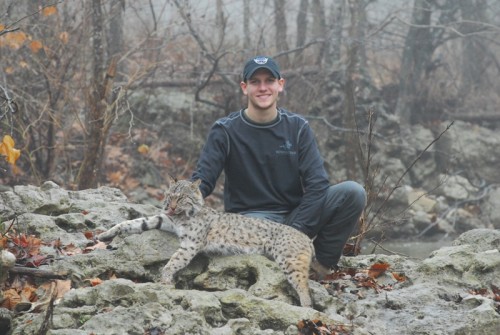
Bobcat that was trapped to help balance predator & prey species.
I trap and call predators for many reasons. I enjoy the challenge of matching skills with a predator. My family and I really like the pelts and we enjoy giving them as gifts. Just as importantly, I wish to attempt to balance the predator/prey relationship on my land so there are plenty of prey (turkey and venison) for my family, our guests, and for the remaining predators to eat.
When I was a younger boy (I’m 50 now), raccoon hides sold for $40+ in my neighborhood and gas was $0.70 per gallon. Now raccoons bring less than $10 in the same area and gas is $3.00 per gallon. We all know the price of fuel, steel, etc., has increased dramatically. There is very little incentive for trappers, except for the love of the work, to remove predators. Predator species have few predators in most areas.
“Balance” is a tough objective to achieve in most aspects of wildlife management. This is because the habitat and populations are always changing. It is a fantasy that wildlife populations or habitat will remain balanced without man’s intervention. Allowing either predator or prey species to build up too high always results in bad results. This has been documented time and time again in species like deer, rabbits, wolves, etc.
However, given that the habitat resources are becoming more and more limited, big swings in population levels don’t recover as easily. I don’t wish for predators – bobcats, opossomus, fox, raccoons, coyotes – to remove most of the prey species -turkey poults, and whitetail fawns – at my farm. I want there to be enough turkey and whitetails for me and the predators. There aren’t many predators of bobcats and coyotes where I live. There certainly aren’t many trappers in my neighborhood. So my efforts to trap some predators will certainly not hurt the coyote or bobcat population in the county.
We tend to actively manage the game species, but have shifted to a protection mindset for predators in some states. On my property, I will work to maintain a reasonable balance between predators and prey. The balance to me means there are plenty of prey (turkey and venison) for my family and the predators to eat. Having just enough prey for only the predators to eat and me shifting to playing ping pong is not an option. I’m going to work to provide good quality habitat which benefits both the predators and prey species, and trap and call to make sure the predators have a predator. Are you managing all the species on your property, or just the prey?
Growing Deer together,
Grant
It’s Time to Rattle!
The pre-rut is happening now throughout much of the whitetail’s range! My Reconyx cameras have taken more images of mature bucks during daylight hours during the past few days than any week since last fall! It’s prime hunting time!
Most does are not receptive yet. However the bucks are ready and eager for a date! They are actively seeking, and therefore very responsive to calls! Bucks may respond to calls at any time during the season, but they are most likely to respond during this stage of the rut.
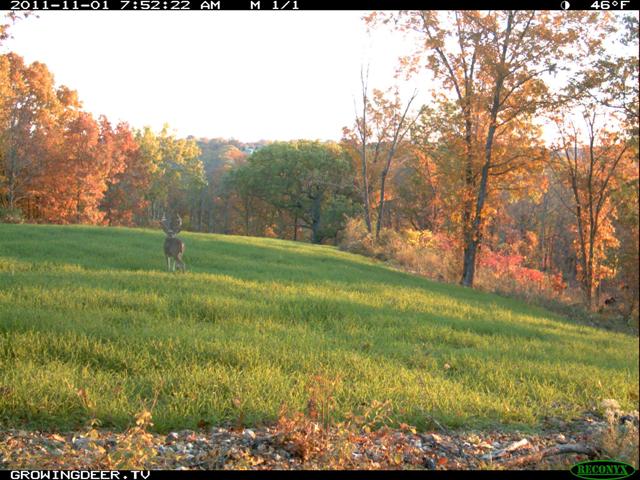
A grunt call is your best choice when a mature buck is nearby.
A fellow biologist and friend of mine, Dr. Mick Hellickson, is both a skilled hunter and researcher. Years ago he designed a study to determine how to rattle to get the most bucks to respond. He and his team tested four different rattling techniques in an area where several bucks were fitted with radio collars. They used the following sequences:
- Short duration and low volume
- Short duration and high volume
- Long duration and low volume
- Long duration and high volume
They had significantly more responses to the long duration and high volume sequence. This is easy to understand. Do you remember watching fights during school? If it was a relatively quiet scuffle between two freshmen, few folks even stopped to watch. Certainly no one even knew to run down the hall and watch.
However, if it was two seniors fighting to gain the attention of the prom queen, there was usually lots of yelling, lockers being rattled, grunts, and moans. It was so loud that most folks in the school ran to watch the fight. Even folks that were not involved with either party came to watch the fight!
The same is true when bucks fight. Yearlings tend to spar, scuffle, and not make many vocalizations when they “fight.” When you were a freshman in school and got into scuffle you probably didn’t want to draw the attention of a big senior or he might decide to settle both of the freshmen in the scuffle down.
However, when the big seniors got into a fight, part of the victory was knowing that everyone was watching!
When I rattle to call deer and no deer are in sight, I want to be a senior! I make as much rattling noise as I can!! I grunt or grunt snort wheeze. I then rattle making as much volume with the tool (antlers, rattle bag, etc.,) as I can. If practical and safe, I use my foot to shake a limb while I’m rattling. I want everyone in the school to know the big boys are fighting!
I don’t do this if I know there is a mature buck close by. This will likely alert him to my exact position. I use this type of calling technique when blind calling or calling when I don’t believe a deer is close by. If I do think a buck is close by, I will often simply grunt lightly and keep increasing the volume until the buck responds. I used the technique last week to call in Clean 12 – a buck that appeared he was going to pass by my stand at 70 yards and was headed to a bedding area (GDTV 101). A simple grunt resulted in Clean 12 making a scrape, rub, vocalizing a snort wheeze and approaching to within three yards of my stand.
Rattling is a great technique to attract mature bucks from a long distance. However, deer are very good at pinpointing the exact location of a call. Therefore they often will approach from the downwind side. This is why I don’t use the loud rattle sequence frequently. I want the buck to hear it once and come searching for the fight participants. I don’t want him to have the opportunity to hone in on the exact location.
My strategy on rattling is probably best summarized by a line in an old movie (I forgot the name of the movie) that goes “If you are going to be a bear, you might as well be a griz.” If you are going to rattle in hopes of calling in a buck when no deer are in view of the stand, make as much noise as you can. You want the bully buck in that area running in to see who is fighting on his turf.
Growing (and calling) Deer together,
Grant
Patterning A Mature Buck
I grew up rabbit hunting. It was the game of choice as there wasn’t a deer season in the county where I was raised. One of my favorite pastimes was tracking or back tracking rabbits in the snow. I probably learned more about rabbits and rabbit hunting by back tracking rabbits in the snow than I did from anything else with the exception of invaluable lessons from my grandfather and father (they were incredible rabbit hunters). In hindsight, those lessons were of huge value to me as a deer biologist and hunter. I learned that critters need food, cover, and water and will use the path of least resistance to move from one to another AS LONG AS THEY DON’T FEEL THREATENED ALONG THOSE PATHS.
The same is true for mature bucks. They need food, cover, and water on a regular basis and will move between these resources along the path of least resistance as long as they don’t feel threatened. One of my hunting tactics is to determine if there are mature bucks in the area by using Reconyx cameras and then use aerial photos to locate the likely sources of food, cover, and water close to the camera that photographed the buck. Notice that I didn’t say I moved the camera to monitor the sources of food, cover, and water. One of my keys to success is being very aware of the bold words in the previous paragraph – AS LONG AS THEY DON’T FEEL THREATENED ALONG THOSE PATHS.
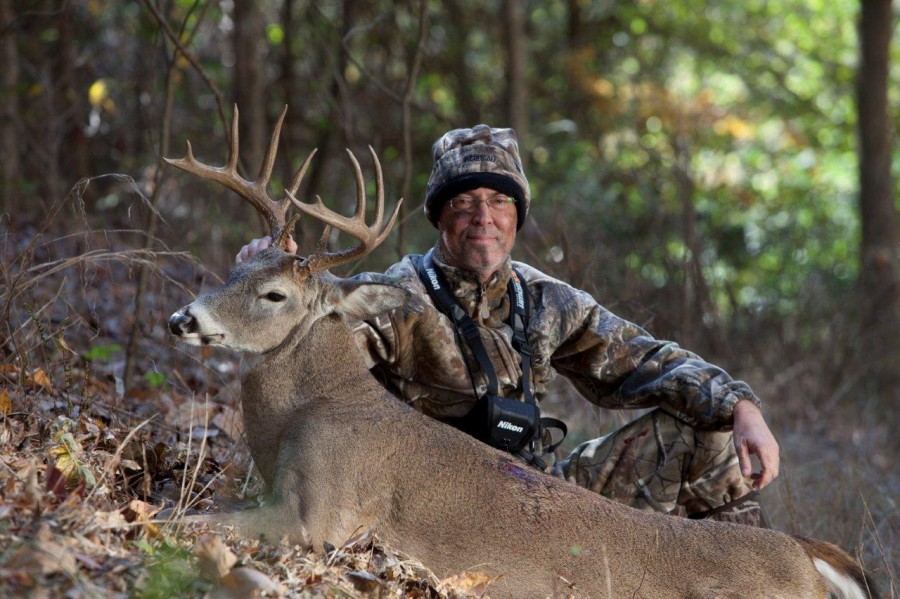
Most of my neighbors hunt and deer are constantly being alerted during the season in my neighborhood. I know deer will range off my property. However, I want to encourage them to spend as much time on my property during daylight hours as possible. That’s one reason why I created sanctuaries! Deer, even during the rut, will likely spend most of the day resting in thick cover. If I can protect bucks during the day, they will have a good chance of surviving to maturity. In addition, if mature bucks are conditioned to finding safety in the same area (sanctuaries), then it’s easier to pattern them.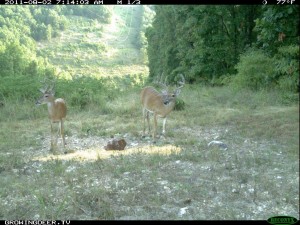
I used this strategy last Friday to kill a buck I had named Clean 12. It was a great hunt as I watched the buck for more than 10 minutes including watching him make a scrape, thrash some limbs with his antlers, and vocalize a snort wheeze. I ended up shooting Clean 12 at three yards! It was a thrilling hunt!! However, what made this encounter with Clean 12 work was simply applying the strategy outlined above.
I had obtained several Reconyx images of Clean 12 during the late summer. I placed some Reconyx cameras in open areas such as Trophy Rock stations and food plots to get a feel for his range and travel patterns.
I knew I wouldn’t likely hunt at any of those camera stations 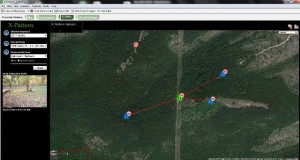 because they were in open areas. Mature bucks would rarely visit them during daylight once season opened. I then used my knowledge of the closest locations for food (used mainly at night by mature bucks this time of year), water (several springs and seeps in the area so no way to predict which source he might use), and cover.
because they were in open areas. Mature bucks would rarely visit them during daylight once season opened. I then used my knowledge of the closest locations for food (used mainly at night by mature bucks this time of year), water (several springs and seeps in the area so no way to predict which source he might use), and cover.
Years ago I had created a sanctuary at the east end of the area where I had images of Clean 12. It seemed the obvious bedding area for Clean 12 . It was the most limiting of three needs a deer has daily (food, water, and cover) in the portion of his range I had confirmed. In addition, I could approach from the east and not enter the area where I had patterned him mainly at night. A northwest, west, or southwest wind would be perfect for the area between where I knew Clean 12 was using and the sanctuary. This area is a de facto transition zone. Deer shouldn’t feel threatened moving into the sanctuary so the site I picked to hang my Muddy stands was the path of least resistance. Finally, the sanctuary was lower in elevation than the ridge where I had determined Clean 12 was using at night and the thermals would be pulling scent downhill (east) and away from where I predicted Clean 12 would be coming from toward the sanctuary.
With my plan in place, Adam (my cameraman) and I were able to approach our stands without alerting deer anywhere to the west of us. About 9 am, I spotted a buck 70 yards away moving toward the bedding area. The habitat work, placement of the Reconyx cameras, and Muddy stands had paid off. You can see the events that occurred when Clean 12 closed the last 70 yards on GDTV 101.
Growing (and hunting) Deer together,
Grant
Harvestable Mature Bucks
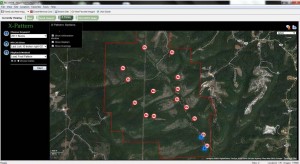
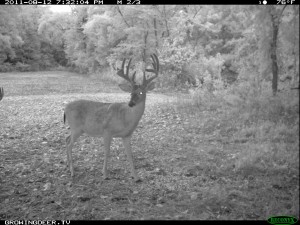 I enjoy studying mature bucks. My Reconyx trail cameras are one of the best tools available to study mature bucks. The cameras themselves don’t spook mature bucks, but there is more to the Reconyx than being a great trail camera. Each camera comes with a free software package, BuckView / MapView, that allows me to easily track the movements and see the pattern of mature bucks. The ability to track where bucks are moving on an aerial image of where I hunt is a tremendous tool.
I enjoy studying mature bucks. My Reconyx trail cameras are one of the best tools available to study mature bucks. The cameras themselves don’t spook mature bucks, but there is more to the Reconyx than being a great trail camera. Each camera comes with a free software package, BuckView / MapView, that allows me to easily track the movements and see the pattern of mature bucks. The ability to track where bucks are moving on an aerial image of where I hunt is a tremendous tool.
I dreamed of tools like this when I was in grad school. However, they were not available or simply cost too much. Now, for the price of a trail camera, I can monitor the movements of mature bucks. Technology is great!

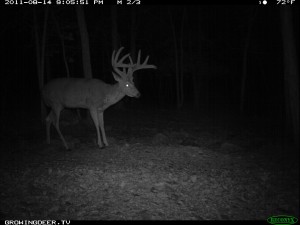 Monitoring the movement of mature bucks does not equate to harvesting a mature buck – but it sure helps. One thing it tells me is the amount of my property a mature buck is using. Some bucks will only use a small portion of a property or have a very small home range. Others mature bucks will have a larger home range or simply use more of the property. This later group includes the bucks that I will focus on while hunting.
Monitoring the movement of mature bucks does not equate to harvesting a mature buck – but it sure helps. One thing it tells me is the amount of my property a mature buck is using. Some bucks will only use a small portion of a property or have a very small home range. Others mature bucks will have a larger home range or simply use more of the property. This later group includes the bucks that I will focus on while hunting.
Bucks are like people – they have different personalities. Some of my friends were raised, got married, and have jobs in the same county where we were born. Others settled far away. As we matured, some of us travel far and wide frequently. Others feel more secure remaining close to their childhood home turf. The same is true with bucks. Each buck has an individual personality. Bucks that have a small range or only use a small portion of the property you hunt can be very difficult to kill. If a buck has a small range, he probably knows every wind current, tree, etc., very well. He can detect change/disturbance to his environment very easily.
Bucks that cover more area probably don’t know each acre nearly as well. In addition, if they are traveling more they are probably crossing more areas that are favorable to hunters (areas where the access, steady wind, etc., favor allowing hunters to select a stand location that won’t alert bucks).
For example, I’m just finishing the annual camera survey at The Proving Grounds. Two mature bucks are using one of my Trophy Rock sites, Last Lick. One of the bucks, Last Lick Right Kicker, only visited the adjoining camera site. He is currently only using a small part of the property where I hunt. I predict I won’t have many encounters with him this fall.
Another mature buck, Last Lick Big 10, is using that same Trophy Rock site and multiple others. When bucks travel relatively far during this time of year, they tend to be moving a lot during hunting season. Although Last Lick Big 10’s pattern may change once he sheds his velvet, I suspect my odds of having an encounter with him this fall are much better!
I’m currently moving my Reconyx units from the location where I do my annual deer herd survey (Trophy Rock locations) to monitoring travel corridors, feeding fields, etc. I’ll use the Reconyx software to track the patterns of these and other bucks. From past research and experience, I’m betting there’s a much better chance my taxidermist meets Last Lick Big 10 than Last Lick Right Kicker. I’ll let you know…
Growing (and hunting) Deer together,
Grant
Doing Laundry for Better Deer Hunting
Most deer hunters are actively preparing for deer season
My preparation includes:
- Habitat/food plot work
- Practicing with my chosen weapon
- Scouting
- Hanging stands/positioning blinds
- Preparing clothes
Most deer hunters engage in some of the above activities. However, one of the most important and often skipped stages is preparing hunting clothes.
A deer’s best defense against predators is its nose. A deer’s eyes and ears are good, but they are simply not in the same league as their nose. I believe that a deer’s nose can detect clothes that have remained in a house, plastic tub, etc., as these tend to have odors that are not common in deer habitat. These strange odors can alert and spook deer.
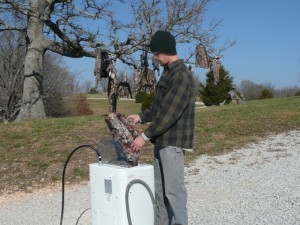 A deer’s reaction to detecting these odors is probably closely related to the current level of predator related stress the deer are experiencing. If they are being harassed by coyotes and other predators, the deer are likely very vigilant and will display a keen reaction to unusual smells.
A deer’s reaction to detecting these odors is probably closely related to the current level of predator related stress the deer are experiencing. If they are being harassed by coyotes and other predators, the deer are likely very vigilant and will display a keen reaction to unusual smells.
There is a lot of hunting at and adjoining my property. There are lots of coyotes in my neighborhood too. The topography is very hilly so the wind seems to swirl constantly. Given these crazy wind patterns, I must attempt to eliminate as many foreign odors as possible. To accomplish this, I wash all my hunting clothes with Dead Down Wind’s E1 Scent Prevent Laundry Detergent. Even though they were washed before being put up last year, I washed them again to remove as much odor as possible. Then I hung the clothes in the sun and allowed them to dry. The sun’s UV is an added cleansing agent.
When scouting or hunting, I use additional steps (shower, etc.) to remove as much scent from my body as possible. However, serious scent elimination means everything I take in the woods has been treated, washed, etc., to reduce scent.
Laundry is an important part of my hunting plan. It’s just as important as practicing with my bow – because without removing scent from my hunting clothes, my only shot this fall may be at the 3D targets in my yard.
Growing Deer together,
Grant



